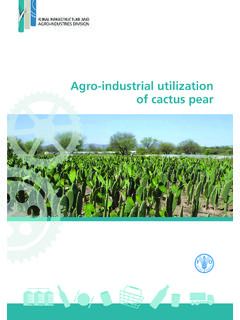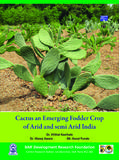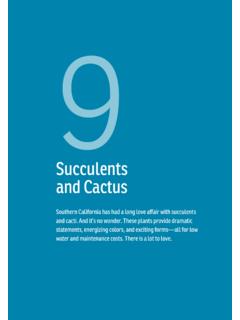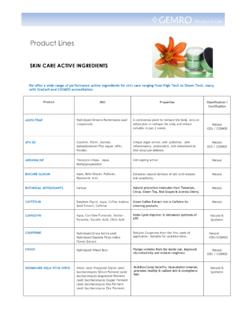Transcription of Frost Sensitivity of Opuntia ficus-indica and O. …
1 Frost Sensitivity of Opuntia ficus - indica and O. robusta in a Semiarid Climate of South Africa Hennie A. Snyman1 Department of Animal, Wildlife and Grassland Sciences Box 339, University of the Free State, Bloemfontein 9300, South Africa e-mail: Herman J. Fouch Agricultural Research Council, Range and Forage Institute Box 339, University of the Free State, Bloemfontein 9300, South Africa Paul L. Avenant Department of Agriculture, Directorate Land Use and Soil Management P/Bag X120, Pretoria 0001, South Africa Clement Ratsele 2 Department of Animal, Wildlife and Grassland Sciences Box 339, University of the Free State, Bloemfontein 9300, South Africa 1 Corresponding author 2 Present address: Department of Livestock Services, Private Bag A82, Maseru 100, Lesotho ABSTRACT There is a lack of information on the adaptability of different spineless cactus-pear cultivars under a range of environmental conditions.
2 A study was conducted to evaluate the cold/ Frost tolerance of 10 cultivars of Opuntia ficus - indica (L.) Miller and one cultivar of O. robusta Wendl. over two growing seasons (2001/2002 to 2002/2003) in a semiarid climate of central South Africa. The cultivars of O. ficus - indica included Algerian, Gymno Carpo, Morado, Nudosa, Roedtan, Sicilian Indian Fig, Tormentosa, Van As, X28 and Zastron. The species O. robusta was represented by the cultivar Monterey. Frost damage was estimated visually, integrating the individual cladode damage over the entire plant. Frost damage only occurred in spring (late-seasonal Frost : August to October) after a combination of frequent successive nights of freezing temperatures (between and ) when the plants already started sprouting. In winter, during dormancy, no plants suffered any Frost damage at freezing temperatures as low as -8oC.
3 For the one-year-old plants (2001/2002 season), Zastron suffered the most Frost damage of all cultivars, with Monterey and X28 most tolerant to freezing temperatures. Algerian, Sicilian Indian Fig, Van As and X28 suffered 100% Frost damage for the two-year-old plants (2002/2003 season). For the same season, Frost damage to Tormentosa and Roedtan was 98%, 97% for Nudosa, 96% for Morado, and 95% for Gymno Carpo. The remaining two cultivars also suffered Frost damage but to a lesser degree (Monterey 41% and Zastron 85%). The reason cactus-pear cultivars were killed can be debated, as there are other successful cactus-pear plantations in the study area. It is believed that freezing temperatures during springtime did not single-handedly cause the death of the cactus-pear plants, but water stress, plant health, and plant phonological stage could also have a bearing on that.
4 To successfully cultivate cactus pear, whether for fodder or fruit production, it is important to select areas that are not prone to severe and late-season Frost . Keywords: Frost damage, Opuntia ficus - indica , O. robusta, phonological stage, plant health, semiarid, water stress Received 22 January 2007; Accepted 21 April 2007. J. PACD 2007 11. INTRODUCTION Developing countries of the world are facing huge challenges in providing enough food for their ever-escalating populations of people and animals. In the arid and semiarid regions of Southern Africa, where annual rainfall ranges from 150 to 300 mm, animal feed scarcity is also common (De Kock, 1965; Snyman, 1998, 2004a). The stock industry suffers major losses as a result of shortage of food during droughts and harsh winters in these areas.
5 The Opuntia cactus is a xerophyte of about 200 to 300 species (Mo hammer et al., 2006) which grows mainly in arid and semiarid zones, is due to their remarkable genetic variability, ecologically adapted to fill this changing gap in feed scarcity. Cactus pear is also a drought-resistant fruit crop (Brutsch, 1997; Gugliuzza et al., 2000; Ratsele, 2003; Galizzi et al., 2004). In many areas cactus-pear fruit is an important food source for satisfying the nutritional needs of people in their countries of origin (Schirra, 1996; Le Hou rou, 1996) for about 3 to 4 months of the year (Inglese et al., 1995; Potgieter, 1995). Knowledge of its chemical composition, nutritional value and effect on human health has lead to a recent increase in the consumption of cactus pear (Livrea and Tesoriere, 2006; Mo hammer et al.)
6 , 2006). There is still scope for increased production on commercial scale for local and export markets of cactus-pear fruit (Feugang et al., 2006). Prices obtained for cactus-pear fruit on the national fresh produce markets of South Africa for example, compare very favorably with those of more common fruits, such as apple, peach, and orange (Brutsch, 1994; Snyman, 2003). The value of spineless cactus pear in subsistence agriculture has been well documented (Le Hou rou, 1992a; Brutsch, 1979, 2000; Barbera, 1995). In the future, declining water resources and global climate change may even increase Opuntia spp. importance as an effective food production system including both fruits and vegetable parts (Stintzing and Carle, 2005; Mo hammer et al., 2006). Cactus-pear species differ with respect to yield, quality, and also in Sensitivity to biotic and abiotic factors, which may affect growth and productivity (Pimienta-Barrios et al.
7 , 1993; Barbera et al., 1993; Le Hou rou, 1996; Wang et al., 1997; Mizrahi and Nerd, 1999; Lahasasni et al., 2003; 2004; Snyman, 2004b; Felker et al., 2005). Although the decade of the 1990 s has seen great expansion in plant physiology and orchard management of cactus pear (Nobel, 1997; Felker and Inglese, 2003), still little horticultural research has been devoted to its productivity under different environmental conditions and management systems (Inglese, 1995; Snyman, 2007). It is increasingly commercialized (Felker and Inglese, 2003) and there is, therefore, a need to evaluate different characteristics to improve the farmer s selection of cultivars and productivity (Wang et al., 1997; Oelofse, 2002). Cold or Frost tolerance of a given cactus-pear species is difficult to assess in a precise way as it depends on a number of local factors (Nobel 1988, 1991, 1994, 2001; Le Hou rou 1994, 1996; Valdez-Cepeda et al.
8 , 2001). According to Le Hou rou (1994) there are no serious cold tolerance problems involved for cactus pear in most arid and semiarid areas. In contrast, Guevara and Estevez (2001) suggested that the cold temperatures of winter are the major limitation to cultivation of cactus pear in some areas. There is, therefore still a need for more intensive studies on the adaptability of this plant under different climatic conditions. Hybridization of cold-tolerant native species with highly productive but cold-sensitive commercial species should be a major objective of breeding programmes to expand cultivation of Opuntia (Gregory et al., 1993, Nobel and Loik, 1993; Mizrahi et al., 1997, Wang et al., 1997; Mondrag n-Jacobo and Per z-Gonz lez, 2000; Valdez-Cepeda et al.
9 , 2001). The most important Opuntia cultivars are generally irreversibly damaged at temperatures of 5 to 12oC (Nobel, 1990; Nobel and Loik, 1993). Cold hardiness of Opuntia spp. used for fruit, forage, or vegetable production has also been reported by Russell and Felker (1987); Gregory et al. (1993), Parish and Felker (1997), Wang et al. (1997) and Guevara et al. (2000). According to Le Hou rou (1971; 2002) Opuntia ficus - indica is among the mildly cold-tolerant species (m > 3oC) and O. robusta is a fairly Frost tolerant species (m > 1oC). The aim of this study was, therefore, to evaluate the Frost or cold tolerance of different Opuntia ficus - indica and O. robusta cultivars in a semiarid climate of central South Africa. J. PACD 2007 22. MATERIALS AND METHODS Site Description The research was conducted on the farm Welgegund (28o 53 S; 26o 56 E; altitude 1,304 m) near a small town called Verkeerdevlei, Free State Province, in South Africa, 60 and 90 km northeast of Glen Agricultural College and Bloemfontein, respectively.
10 Other climatic data used in this study was obtained from a new weather station established in January 2001 close to the study area. Long-term data was obtained from Glen weather station (70 years data) (Botha, 1964) and stored on the national climatologically weather database of the Institute for Soil, Climate and Water of the Agricultural Research Council (ARC) in South Africa. All climatic data were obtained from automatic recorders on an hourly basis. The months December, January, and February are the hottest months, with long-term mean temperatures of , , and C, respectively (Table 1). In general the winters are cold with mean minimum temperatures for the months June and July lower than 0 C. The first Frost can be expected as early as 23 March (Botha, 1964).







